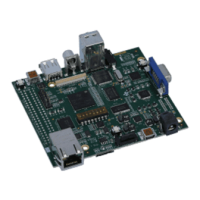Boot Loader
Therefore, the UART must be configured and the UART pins switched to their hardware function
before calling the boot loader.
2.2.2 SSI Interface
The SSI pins SSIFss, SSIClk, SSITx, and SSIRx are used to communicate with the boot loader.
The device communicating with the boot loader is responsible for driving the SSIRx, SSIClk, and
SSIFss pins, while the microcontroller drives the SSITx pin.
The serial data format is fixed to the Motorola format with SPH set to 1 and SPO set to 1 (see the
data sheet for more information on this format). Since the system clock must be at least 12 times
the serial clock rate, the maximum serial clock rate that can be used is 1.3 MHz (which is 16 MHz
divided by 12).
When an application calls back to the ROM-based boot loader to start an update over the SSI port,
the SSI configuration and pin configuration is bypassed. Therefore, the SSI port must be configured
and the SSI pins switched to their hardware function before calling the boot loader.
2.2.3 I2C Interface
The I2C pins I2CSCL and I2CSDA are used to communicate with the boot loader. The device
communicating with the boot loader must operate as the I2C master and provide the I2CSCL signal.
The I2CSDA pin is open-drain and can be driven by either the master or the slave I2C device.
The I2C interface can run at up to 400 KHz, the maximum rate supported by the I2C protocol. The
boot loader uses an I2C slave address of 0x42.
When an application calls back to the ROM-based boot loader to start an update over the I2C port,
the I2C configuration and pin configuration is bypassed. Therefore, the I2C port must be configured,
the I2C slave address set, and the I2C pins switched to their hardware function before calling the
boot loader. Additionally, the I2C master must be enabled since it is used to detect start and stop
conditions on the I2C bus.
2.2.4 Serial Protocol
The boot loader uses well-defined packets on the serial interfaces to ensure reliable communica-
tions with the update program. The packets are always acknowledged or not acknowledged by the
communicating devices. The packets use the same format for receiving and sending packets. This
includes the method used to acknowledge successful or unsuccessful reception of a packet. While
the actual signaling on the serial ports is different, the packet format remains independent of the
method of transporting the data.
The following steps must be performed to successfully send a packet:
1. Send the size of the packet that will be sent to the device. The size is always the number of
bytes of data + 2 bytes.
2. Send the checksum of the data buffer to help ensure proper transmission of the command.
The checksum is simply a sum of the data bytes.
3. Send the actual data bytes.
8 April 8, 2013
